
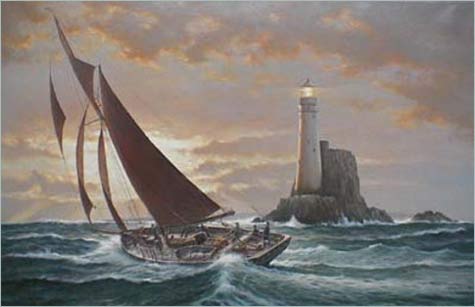
Painting of Jolie Brise by Rodney Charman
Rodney Charman of Lymington, Hants in UK a self taught well established marine artist, has a deep interest in sailing ships, an interest reflected in his paintings. When I knew that John Stubbs and Richard Gross of Auckland’s Ancient Mariners were producing sailing models of the famous cutter, Jolie Brise, having seen the painting of her heading towards the Fastnet Rock by Rodney Charman, I emailed him and he was kind enough to permit me to use it in my column.
As regular readers may recall, occasionally I show marine paintings that I find particularly beautiful. Rodney Charman’s painting seen above is no exception, no small wonder his work hangs in galleries, and in peoples homes all over the world.

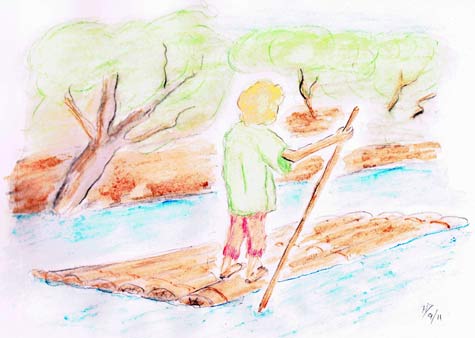
Harry Duncan ‘s work for this column
captures the very spirit of a boys early rafting
I got to wondering back in June as I too floated onwards in time toward the 77th anniversary of my life. whatever happened to the gentle art of simple rafting that going way back in time to my days as a wee lad I had been enthralled with when reading about the likes of Hucklebury Finn and his mate Tom Sawyer.
Rafting it seemed had been overtaken by speedier means of propulsion like sailing and powered boats, its objective of simple `adventure’ swallowed up by the need to get somewhere fast (and often first) and the simply `drift on the tide’ ideal replaced by the likes of extreme rafting on pounding rivers and rapids often aimed at tourists and the extraction of the tourist dollar. The simple and inexpensive had just vanished!

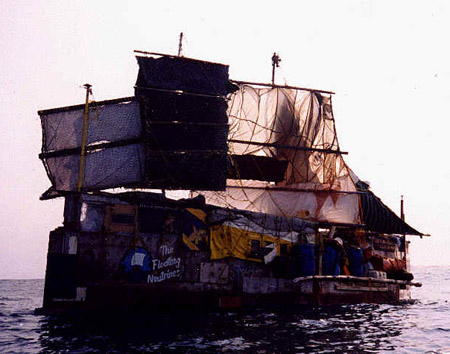
A raft built of New York city junk
Extensive searching and research on the internet seemed to indicate that aside from charity events here and there on rivers and streams where rafts are used to race others short distances there was little else, that was until browsing further I came upon the name David Pearlman alias Poppa Neutrino and his rafts built from New York City scrap materials such as Town Hal l (presumably the material came from a building once a Town Hall!)and the larger Son of Town Hall pictured above that was made from scrap collected in New York City.
I read that a book had been written, borrowed it from a local library and devoured it in `can’t put down’ fashion to learn about the man whom author Alec Wilkinson called The Happiest Man in the World, his search for fulfillment and happiness and his family of ex and current wives (and children) known as the Floating Neutrino’s, dogs and all.
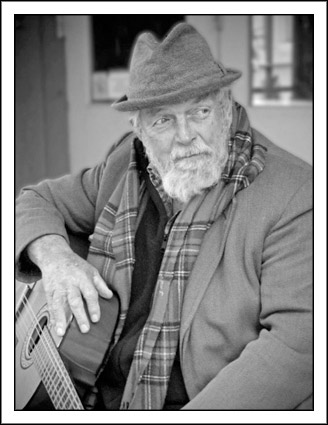
David Pearlman alias Poppa Neutrino.
Photo by Chris Bell
After reading the book I first intended to undertake a review but it has already been well acclaimed and suffice to say that it is an excellent book by a superb writer. Those that feel like a gripping read about ocean rafting and the storms encountered, and about quite an amazing, somewhat complex man who incidentally died at age 77 in, New Orleans on 23 Jan 2011, then borrow it from your local library. (If you are looking for murder and sex you won’t find them in this book, but I think you will learn a great deal about one man’s character and the depth of his beliefs and the intensity of his determination to pursue his dreams despite failing health and much adversity.
Since Pearlman started calling himself Poppa Neutrino you might like to know that a `neutrino’ is an itinerant particle so minute it can hardly be seen. If I can borrow from the book’s inside cover, to Neutrino it represented the elements of one’s hidden life, of which I would say he had many.
A wanderer, philosopher, adventurer, street musician, church founder and preacher, a member of the Explorers Club, an American football offensive movement strategist, a sign painter, raft builder, ocean crosser, Neutrino, often a pauper (who when he died had but four and a half greenbacks in his bank account) was a one off the mold, laughed at by many, his passing later bemoaned by hundreds.
He was very much a free spirit born in the USA and travelling the length and breadth of that nation over and over and over again in his span of years. In one of the obituary tributes, someone described him aptly when bemoaning his passing as being a man `unmoored on land, an adventurer at sea!’
But what about these oft-crazy, totally unconventional rafts he and other members of his family and itinerant followers built, therein is an integral part of the story of his life, the rafts made of salvaged lumber, cardboard, chipped and broken plastic sheeting and general city rubbish. Aboard the 51’ Son of Town Hall he, Betsy, one or two others and three dogs made crossing of the North Atlantic from Newfoundland to Ireland.
The book that awakened the writer's interest. |
Son of Town Hall captured the imagination of many
|
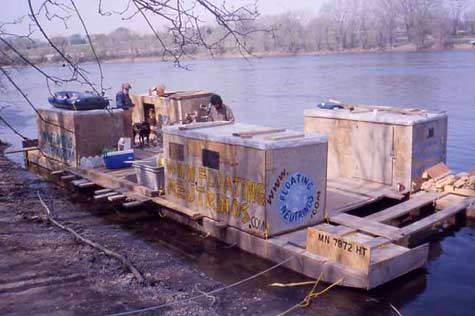
The Neutrino raft Vilma B
There were other rafts also, the Vilma B for the trip on the Mississippi, Absolute Absolution a 53’ catamaran, and Dragonfly’s Banquet… and always another raft that he had on his mind with intentions of building. Writing about the man’s life would have presented much difficulty to the author of the book for it appears that Poppa Neutrino moved about virtually on impulse and without much if any warning.
Wilkinson who has written several acclaimed books and who worked as a writer at The New Yorker, on many occasions travelled around with him, perhaps the only way of documenting the kind of life Neutrino lived. When he died, the quantity of publications including blogs that appeared on the internet paying tribute to the man and his lifestyle was quite amazing, many from people who had just heard of him but did not know him.

I don’t know who wrote the saying `death steals everything except our stories’ but Poppa Neutrino lived such an incredible varied life and had so many interests, it is fortunate to those who knew and admired the man, following him in what must have seemed at times to be madcap dreams that the book by Wilkinson was written.
My thanks to Betsy, Neutrino’s second wife from whom I have had some help and for her permission to use photographs, and to Chris Bell who took the photograph of Neutrino also to Alec Wilkinson who wrote the book that started me in my quest to learn more about a somewhat incredible character and his seaborne, carried-on-the-tide, helped-by-the-wind creations.
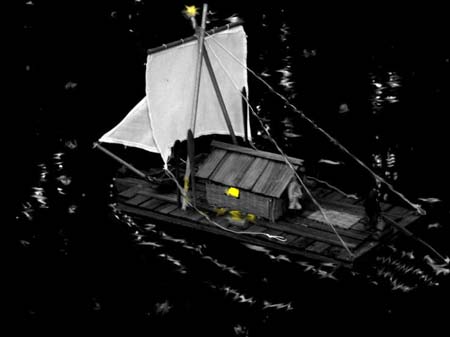
A really nice photo (directly above) to finish this item, one taken By Bill Gardam of Salt Spring Island of British Columbia situated off the West Coast of Canada, the model raft that he built photographed by him sailing at night. It is a photograph that captures the atmosphere and conveys a mood and I am grateful to Bill for his agreement to my sharing it. A really talented and interesting man whom you might hear more about in a future column.

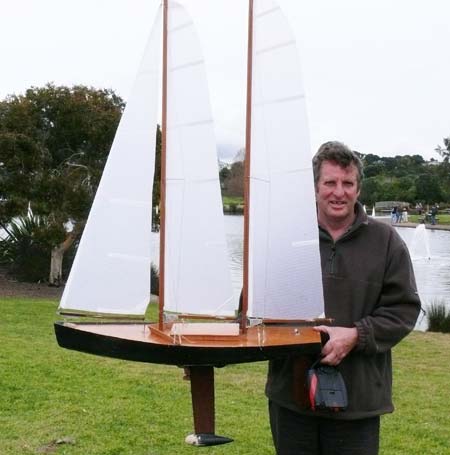
Laurie Pittams with Two AM
It has been awarded annualy for fourteen years, `it’ being the trophy presented in 1998 to Auckland’s Ancient Mariners sailing group by the Great Schooner Model Society based in Maryland, USA.
Awarded for production mainly of schooner-rigged sailing models, each winner keeps the trophy on which details have been engraved for a year, and the winner for the 2011-2012 period is Laurie Pittams for his Smeed Starlet based schooner Two AM shown with him above.

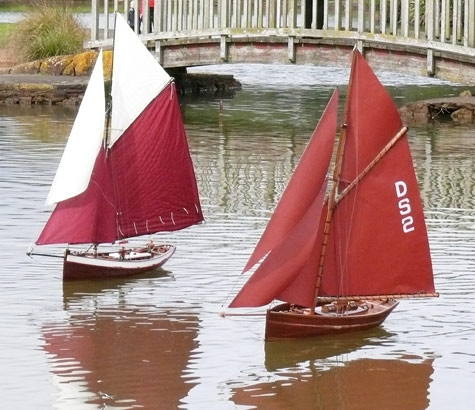
The Olivia G (left facing) and the Jolie Brise at right
The cutter Jolie Brise (and one should say that like a true Frenchman!) is one of the most famous sailing boats of all times. Twice a winner of the Fastnet Race, this item deals with two Jolie Brise RC models built and now sailing with the Ancient Mariners windling group at Onepoto in Auckland, New Zealand.
Richard Gross has built the Olivia G and John Stubbs has named his what it represents, (Jolie Brise) and both models are now operational are very much the centre of attraction at Onepoto lake when the fleet sails on Thursday mornings.
Lets go my way |
No lets go my way
|
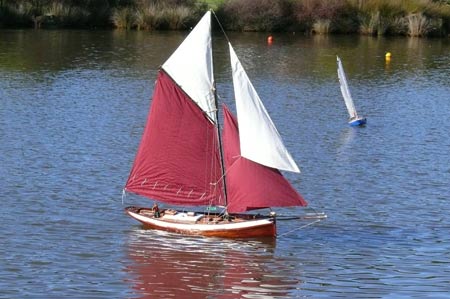

Helmsman Ernest in earnest mood
Let us each go our own way! |
Powered up and on a run
|
Richard’s cutter was built plank on frame on temporary frames, the hull and cabins of mahogany, the deck of New Zealand kauri, mast and spars of carbon fishing rod blanks. The length overall (less bowsprit is 1170mm, beam is 320mm and she draws 370mm.
The Olivia G is fitted with 3 overlapping jibs and when all sails are used the approximate sail area totals 12020 square metres. The cutter has 5kgs of ballast and an approximate all up boat weight of 13.1 kgs. The plan sourse was the Jolie Brise website. She was the second of the pair of boats to be launched.
John Stubbs Jolie Brise is slightly shorter on the deck at 1058mm, the hull built plank on frame of mahogany, the deck of kauri, masts and spares of Oregon. At 142 kgs she is heavier than Richard’s model and that includes ballast.
Sail cloth was used for all sails, there are two overlapping sails and the approximate sail area when all sails are used is .7937 sq m.
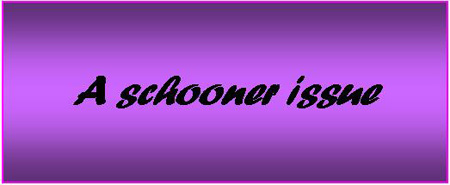
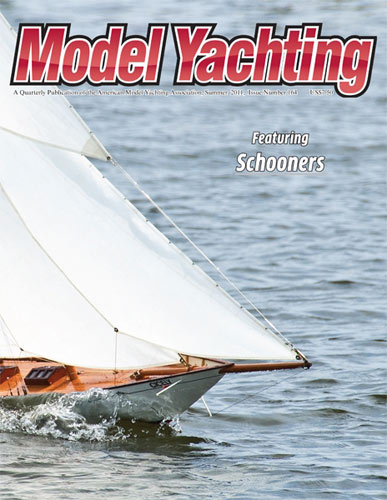
The American Model Yachting Association in their Issue 164 of their quality magazine for members of the association, Model Yachting made it a Schooner issue, the front and back covers having featured a Pat Butterworth photos of South Carolina’s Andrew Charters fine Fife schooner CICELY.
The magazine which goes only to members of the AMYA is published four times a year and is always 60 pages, It contains AMYA class information and a great deal on racing, and reports by the class secretaries, information of ruling developments, tuning hints and an abundance of mainly racing photos. To be a member of the AMYA costs US$35 (non US countries US$50 a year which includes the magazine.

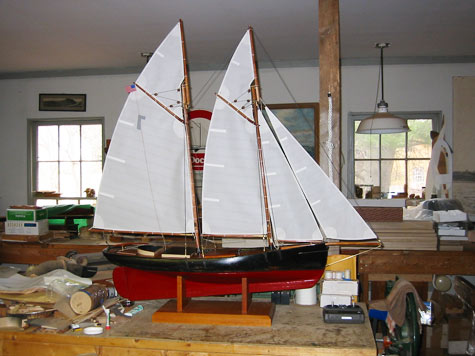
The restored Atlantide in the workshop
Mike deLesseps sent me this photo of a schooner he `put right’ (restored from junk) some years ago from an old abandoned hull purchased at a Maritime Museum auction in Bath. Given his effort it later sailed quite well as the rig seemed well balanced.
The hull was about 34” long and was carved out of a solid bit of wood but it had checked badly as a solid block tends to do over time. Mike repaired the checked areas with stainless screws, epoxy and covered them with with cross grain plugs and a sail control was fitted with a strong servo with one arm working all the sheets fore and aft. It was a great looking model under sail as the second photograph shows and it was a favourite at the boat pond.
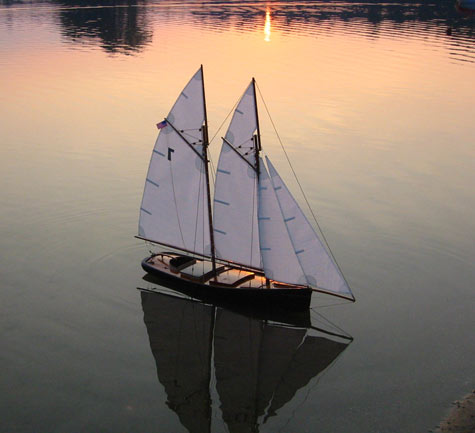
A late evening return
Alas, this Atlantide perished along with several other model boats in a shop fire many years ago. Sad development that, considering it was a salvage job returned many years later to a working model and several who had seen it questioned the wisdom of restoring it when (they felt that) it had belonged in the wood pile.

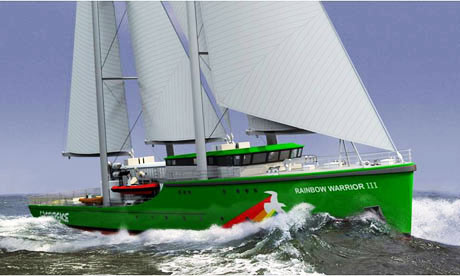
This is an image of the ship
Don’t call it a schooner (I’ve read) though it sure looks like one, the new Rainbow Warrior 111 built specifically for the needs of Greenpeace. Built primarily to sail with two A frame masts and sails that have been optimized for highly effective sailing, it has the option to switch over to engine powered, diesel electric propulsion.
The steel-hulled vessel is 57.92m overall and_was designed in Amsterdam in the Netherlands by Gerard Dijkstra & Partners and has a helipad at the stern. The cost – estimated at fourteen million pounds! In the distinctive Greenpeace livery it would make a nice model I think. Certainly different!


Puritan – Bill Huizing’s latest
A lovely sight, such classic lines |
The shy builder Bill Huizing
|

The mighty purdy Puritan
All photos in this item are by
Pat Butterworth
It is said that the talented US shipmodeller, Bill Huizing is so bashful and camera-shy that were he faced with a camera he would rather up and move to another State to avoid being photographed!
I have featured models by him before but I know that readers will enjoy seeing his latest sailing boat model, that of Puritan the 1885 America’s Cup US defender designed by Edward Burgess.
Built in Boston and launched May 26th Puritan defeated the New York Yacht Club’s Priscilla thereby earning the right to defend the cup against the cutter Genesta.
The length of the Puritan model (from the tip of the bowsprit to th end of the main boom is 88”, the height of the mast above the deck only 63”. The model built in 1/20th scale has a carved hull. The real Puritan was later re-fitted as a schooner, and Genesta built in 1884 was in later years I believe also re-rigged as one. (I’ll cover myself – that may have been the case!)

-30- | 
